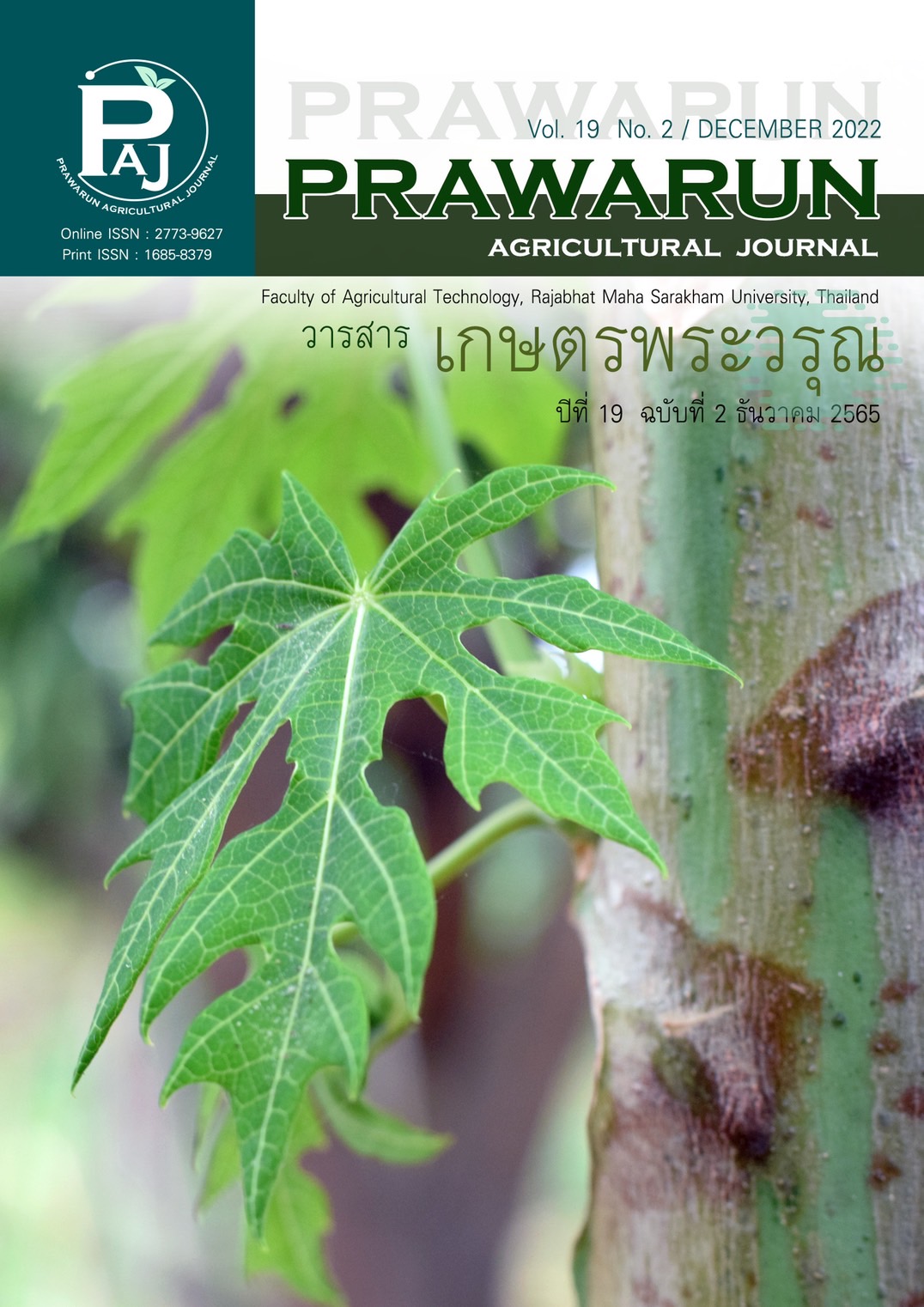การศึกษาคุณภาพและการยอมรับทางประสาทสัมผัสของน้ำอ้อยคั้นสด
Main Article Content
บทคัดย่อ
น้ำอ้อยคั้นสดเป็นเครื่องดื่มที่คนไทยนิยมบริโภคมายาวนานแต่การศึกษาด้านคุณภาพและการยอมรับยังมีอย่างจำกัด ดังนั้น การศึกษานี้จึงมีวัตถุประสงค์เพื่อศึกษาคุณภาพและการยอมรับน้ำอ้อยคั้นสดของอ้อยคั้นน้ำพันธุ์สุพรรณบุรี 50 (SP50) พันธุ์ศรีสำโรง 1 (SR1) และโคลนดีเด่น 2 โคลน ได้แก่ โคลน UTj10-3 และ UTj10-19 ที่เก็บรักษาในขวดแก้ว
นาน 0, 2 และ 4 วัน ที่อุณหภูมิ 4 ºC จากการศึกษาพบว่า พันธุ์/โคลนของอ้อยคั้นน้ำและระยะเวลาการเก็บรักษาที่แตกต่างกันมีผลต่อคุณภาพและการยอมรับน้ำอ้อยคั้นสด โดยค่าความเป็นสีเขียว (-a*) และค่าความเป็นสีน้ำเงิน (-b*) มีค่าแตกต่างกันอย่างมีนัยสำคัญยิ่งทางสถิติซึ่งพันธุ์ SR1 มีค่าความเป็นสีเขียวต่ำสุด เท่ากับ -2.750 และพันธุ์ SP50 มีค่า
ความเป็นสีน้ำเงินต่ำสุด เท่ากับ -1.371 ขณะที่การเก็บรักษาที่ยาวนานขึ้นมีผลให้น้ำอ้อยคั้นน้ำมีค่าความเป็นสีเขียวลดลง ด้านค่าของแข็งทั้งหมดที่ละลายได้ (TSS) ค่าความเป็นกรด-ด่าง (pH) และค่าการนำไฟฟ้า (EC) พบว่าโคลน UTj10-3 มีค่า TSS สูงสุด เท่ากับ 21.43 ºBrix ขณะที่ พันธุ์ SR1 มีค่า pH สูงสุด เท่ากับ 5.51 และโคลน UTj10-19 มีค่า EC สูงสุด เท่ากับ 4.114 mS/cm อย่างไรก็ตาม พบว่า อายุการเก็บรักษามีผลให้ค่า EC และค่าการตกตะกอนของน้ำอ้อยคั้นสดมีค่าแตกต่างกันอย่างมีนัยสำคัญยิ่งทางสถิติ สำหรับการประเมินการยอมรับทางประสาทสัมผัสนั้นผู้ทดสอบให้คะแนนความชอบโคลน UTj10-3 ใกล้เคียงกับพันธุ์ SP50 ที่มีระดับคะแนนแต่ละลักษณะส่วนใหญ่สูงสุดเมื่อเปรียบเทียบกับพันธุ์/โคลนอื่น ๆ ที่อายุการเก็บรักษาเดียวกัน
Article Details
เอกสารอ้างอิง
Aziz, N., Mat Nor, N. A., Mohd Adnan, A. F., Taha, R. M., & Arof, A. K. (2012). Study of anthocyanin stability derived from the fruit pulp of Melastoma malabathricum in a coating system. Pigment and Resin Technology, 41(4), 223–229. doi: http://doi.10.1108/03699421211242455.
Eghbaliferiz, S., & Iranshahi, M. (2016). Prooxidant activity of polyphenols, flavonoids, anthocyanins and carotenoids: updated review of mechanisms and catalyzing metals. Phytotherapy Research, 30(9), 1379-1391.
Hunter, R. S., & Harold, R. W. (1987). The measurement of appearance (2nd ed.). New York: John Wiley-Inter science.
Kasunmala, I. G. G., Navaratne, S. B., & Wickramasinghe, I. (2020) Antioxidant activity and physicochemical properties changes of Melastoma malabathricum (L.) and Syzygium caryophyllatum (L.) fruit during ripening. International Journal of Fruit Science, 20(Suppl. 3), S1819-S1828. doi: 10.1080/15538362.2020.1834896.
Kropf, D. H. (2003). Enhancing meat color stability. Proceedings of the 56th American meat science association reciprocal meat conference (pp. 73-75). Columbia: Missouri.
Krzywicki, K. (1979). Assessment of relative content of myoglobin, oxymyoglobin and metmyoglobin at the surface of beef. Meat Science, 3(1), 1-10. doi: 10.1016/0309-1740(79)90019-6.
Lindahl, G., Lundstrom, K., & Tornberg, E. (2001). Contribution of pigment content, myoglobin forms and internal reflectance to the colour of pork loin and ham from pure breed pigs. Meat Science, 59(2), 141–151. doi: 10.1016/s0309-1740(01)00064-x.
Mancini, R. A., & Hunt, M. C. (2005). Current research in meat color. Meat science, 71(1), 100–121. doi: 10.1016/j.meatsci.
03.003.
Monino, I., Martínez, C., Sotomayor, J. A., Lafuente, A., & Jordán, M. J. (2008). Polyphenolic transmission to Segureno lamb meat from ewes’diet supplemented with the distillate from rosemary (Rosmarinus officinalis) leaves. Journal of Agricultural and Food Chemistry, 56(9), 3363-3367.
Morrissey, P. A., Sheehy, P. J., Galvin, K., Kerry, J. P., & Buckley, D. J. (1998). Lipid stability in meat and meat products. Meat Science, 49 (Suppl. 1), S73-S86.
Omar, S. N. C., Abdullah, J. O., Khairoji, K. A., Chin, S. C., & Hamid, M. (2013). Effects of flower and fruit extracts of Melastoma malabathricum Linn. on growth of pathogenic bacteria: Listeria monocytogenes, Staphylococcus aureus, Escherichia coli, and Salmonella typhimurium. Evidence-Based Complementary and Alternative Medicine, 2013(2):459089. doi: 10.1155/2013/459089.
Omar, S. N. C., Abdullah, J. O., Khairoji, K. A., Chin, S. C., & Hamid, M. (2012). Potentials of Melastoma malabathricum Linn. flower and fruit extracts as antimicrobial infusions. American Journal of Plant Sciences, 3(8), 1127-1134. doi: 10.4236/ajps.2012.38136.
Park, J. H., Kang, S. N., Shin, D., & Shim, K. S. (2015). Antioxidant enzyme activity and meat quality of meat type ducks fed with dried Oregano (Origanum vulgare L.) powder. Asian-Australasian Journal of Animal Sciences, 28(1), 79-85. doi: 10.5713/ajas.14.0313.
Pastsart, U. (2019). Effect of Melastoma malabathricum supplementation in drinking water on growth performance, carcass and meat quality of broilers. Khon Kaen Agriculture Journal, 47(Suppl. 1), 769-774. (in Thai)
Pastsart, U., De Boever, M., Claeys, E., & De Smet, S. (2013). Effect of muscle and post-mortem rate of pH and temperature fall on antioxidant enzyme activities in beef. Meat science, 93(3), 681–686. doi: 10.1016/j.meatsci.2012.11.008.
Pastsart, U., Nakawiroj, P., Pimpa, O., Rattanawut, J., & Khamseekhiew, B. (2021). Antioxidant capacity and lipid oxidation in meat during cold storage of broilers fed with sweet basil (Ocimum basilicum) leaves. Khon Kaen Agriculture Journal, 49(Suppl. 2), 862-866. (in Thai)
Qwele, K., Hugo, A., Oyedemi, S. O., Moyo, B., Masika, P. J., & Muchenje, V. (2013). Chemical composition, fatty acid content and antioxidant potential of meat from goats supplemented with Moringa (Moringa oleifera) leaves, sunflower cake and grass hay. Meat Science, 93(3), 455–462.
Renerre, M., Dumont, F., & Gatellier, P. (1996). Antioxidant enzyme activities in beef in relation to oxidation of lipid and myoglobin. Meat Science, 43(2), 111–121. doi: 10.1016/0309-1740(96)84583-9.
Sharma, O. P., & Bhat, T. K. (2009). DPPH antioxidant assay revisited. Food chemistry, 113(4), 1202-1205.
Song, F. L., Gan, R. Y., Zhang, Y., Xiao, Q., Kuang, L., & Li, H. B. (2010). Total phenolic contents and antioxidant capacities of selected Chinese medicinal plants. International journal of molecular sciences, 11(6), 2362-2372. doi: 10.3390/ijms11062362.
Susanti, D., Sirat, H. M., Ahmad, F., Ali, R. M., Aimi, N., & Kitajima, M. (2007). Antioxidant and cytotoxic flavonoids from the flowers of Melastoma malabathricum L. Food Chemistry, 103(3), 710-716.
Tarladgis, B. G., Watts, B. M., Younathan, M. T., & Dugan, L. (1960). A distillation method for the quantitative determination of malonaldehyde in rancid foods. Journal of the American Oil Chemists' Society, 37, 44–48.
Wang, L., Guo, H., Liu, X., Jiang, G., Li, C., Li, X., & Li, Y. (2019). Roles of Lentinula edodes as the pork lean meat replacer in production of the sausage. Meat science, 156(1), 44-51. doi: 10.1016/j.meatsci.2019.05.016.
Yao, Y., Sang, W., Zhou, M., & Ren, G. (2010). Phenolic composition and antioxidant activities of 11 celery cultivars. Journal of Food science, 75(1), C9-C13. doi: 10.1111/j.1750-3841.2009.01392.x.
Zakaria, Z. A., Rofiee, M. S., Mohamed, A. M., Teh, L. K., & Salleh, M. Z. (2011). In vitro antiproliferative and antioxidant activities and total phenolic contents of the extracts of Melastoma malabathricum leaves. Journal of Acupuncture and Meridian Studies, 4(4), 248-256. doi: 10.1016/j.jams.2011.09.016.


